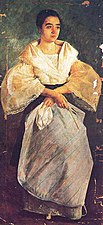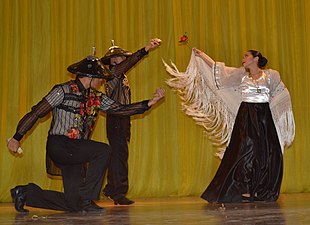Pañuelo
 Early 19th centurypañuelo.Metropolitan Museum of Art | |
| Type | Kerchief, shawl |
|---|---|
| Material | Piñafiber |
| Place of origin | Philippines |

Thepañuelooralampayis aFilipinolace-like embroidered neck scarf or shawl worn around the shoulders over thecamisa(blouse). They were square-shaped and were folded in half into a triangle when worn.Pañuelosare the direct predecessors of theManila shawl.The Spanish wordpañuelo(frompaño+-uelo) means kerchief, scarf, and handkerchief.
Description
[edit]Pañueloswere traditionally made from sheer lace-likenipistextiles woven fromabacafiber. They were square-shaped and were folded in half into a triangle when worn around the shoulders. They commonly featured floral embroidery (using techniques likecalado,sombrado,anddeshilado). In addition to the nativeabacáfiber, they were also made frompiñafiber, acquired frompineapplesintroduced by the Spanish. They also featured borders oflaceor knottedfringes,a Spanish element which itself was acquired from theMoors.[1][2][3]
They were an integral and distinctive part of the traditionalbaro't sayaensemble of Filipino commoners and thetraje de mestizaensemble of aristocratic Filipino women (along with thetapisand theabanikofans), as they brought modesty to the relatively low neckline of the traditionalcamisashirts. They were worn in the 18th and 19th centuries but are rarely used today in modern versions of theternodress.[1][2][3]
History
[edit]Pañueloswere derived from traditional shawls in thepre-colonial Philippinesknown asalampay;head and neck coverings among pre-colonialTagalogwomen. These were carried over into theSpanish colonial periodand acquired European design motifs. They were also luxury goods exported via theManila galleonstoNueva EspañaandEurope;sometimes as gifts to royalty.[1][2]
Pañueloswere copied byChinesetraders during the 18th and 19th centuries, and sold to the Philippines, Spain, and other Spanish colonies. These copies were made from silk with Chinese motif embroidery. They became immensely popular in the Philippines and were quickly adopted into the local fashions of upper classLuzonwomen. Similarly, they became widely sought-after luxury exports soon after they reached the Americas, where they became known as themantón de Manila.[4][5][6]They are believed to have influenced later designs of therebozoofLatin America.[7]
Modern Usage
[edit]Since the 1930s pañuelos have been part of the modernized traje de mestiza. In modern days pañuelo can still be seen worn with the modern terno; especially on older women. Pañuelo or alampay has also been an integral part ofIglesia ni Cristochurch uniforms worn by deaconesses in all locale congregations in the Philippines. This white terno, calledSayain Filipino, resembles its early deaconess uniforms worn during the 1930s. They can be decorated with embroidery or have simple designs.
Gallery
[edit]-
An 1668 illustration byFrancisco Ignacio Alcinadepicting aVisayandatuand abinukotnoblewoman with a veil (alampay) and asalakot
-
Tagalogcouple from theBoxer Codex(c. 1590), the woman is wearing analampayaround her shoulders, the precursor to the pañuelo and theManila shawl
-
La Bulaqueña,an 1895 painting of a woman wearing atraje de mestizawith a pañuelo
-
La MestisabyJustiniano Asuncion(c. 1841), showing a woman in a stripedbaro't sayawith apañuelo
-
Woman in atraje de mestizawith apañueloandabanicofolding fan (c. 1900)
-
Dancers from thePhilippinesperformingJota Manileña.The woman is wearing amantón de Manilaover her traditionaltraje de mestizadress
See also
[edit]References
[edit]- ^abcSumayao, Marco (24 May 2018)."Can the Baro't Saya Ever Return as an Everyday Filipino Fashion Staple?".Town&Country.Retrieved19 May2019.
- ^abcRamos, Marlene Flores (2016).The FilipinaBordadorasand the Emergence of Fine European-style Embroidery Tradition in Colonial Philippines, 19th to early-20th Centuries(Thesis). Mount Saint Vincent University.
- ^ab"Terno".SEASite.Center for Southeast Asian Studies, Northern Illinois University.Retrieved16 December2018.
- ^Arranz, Adolfo (27 May 2018)."The China Ship".South China Morning Post.Retrieved19 May2019.
- ^Nash, Elizabeth (13 October 2005).Seville, Cordoba, and Granada: A Cultural History.Oxford University Press. pp. 136–143.ISBN9780195182040.
- ^Maxwell, Robyn (2012).Textiles of Southeast Asia: Trade, Tradition and Transformation.Tuttle Publishing.ISBN9781462906987.
- ^Schevill, Margot Blum; Berlo, Janet Catherine; Dwyer, Edward B., eds. (2010).Textile Traditions of Mesoamerica and the Andes: An Anthology.University of Texas Press. p. 312.ISBN9780292787612.







